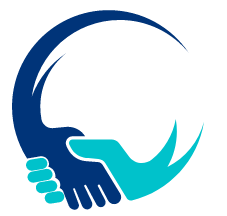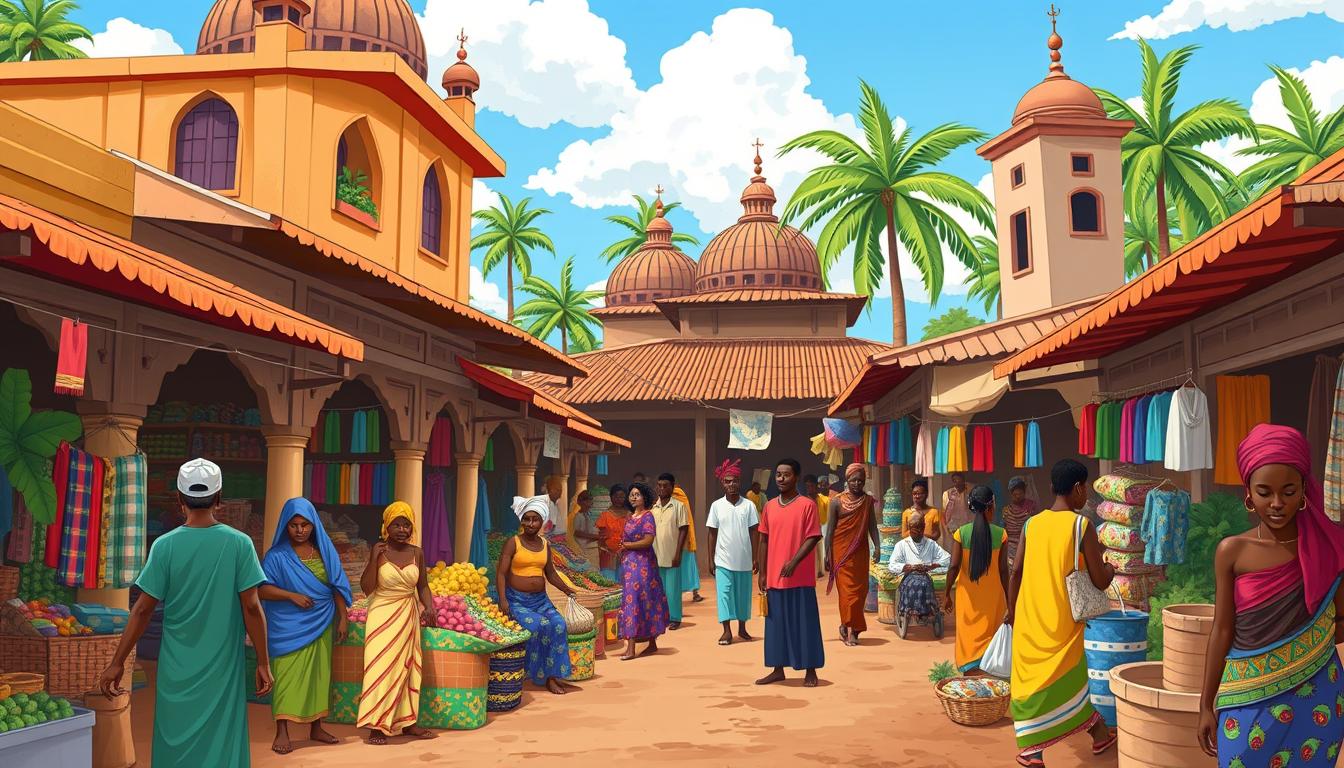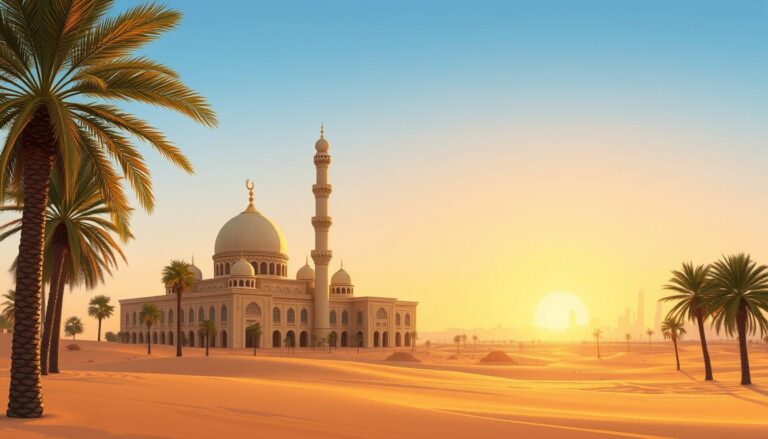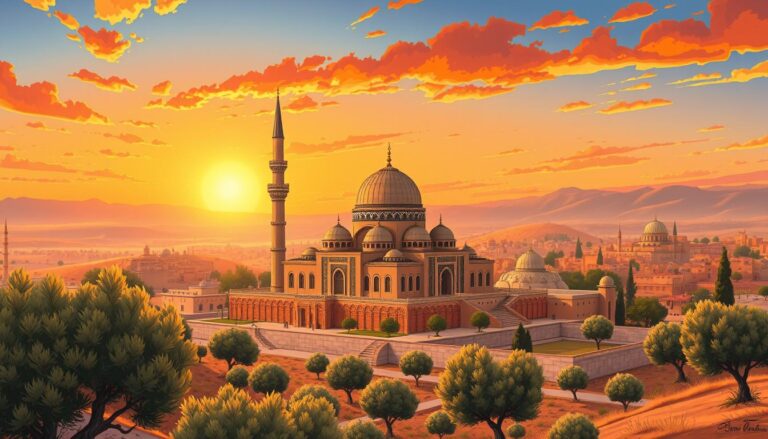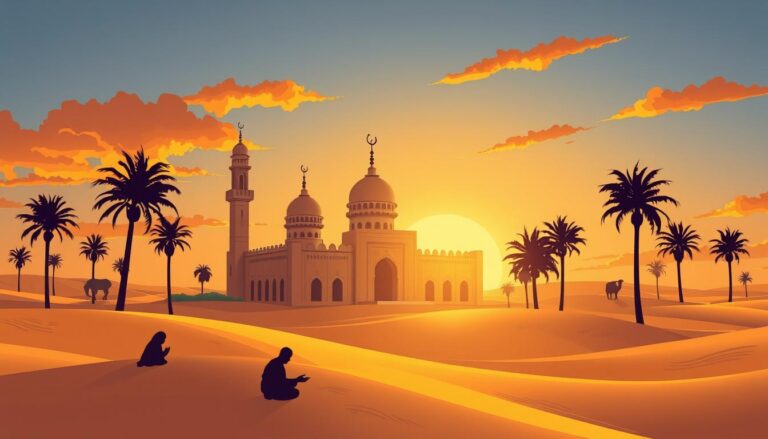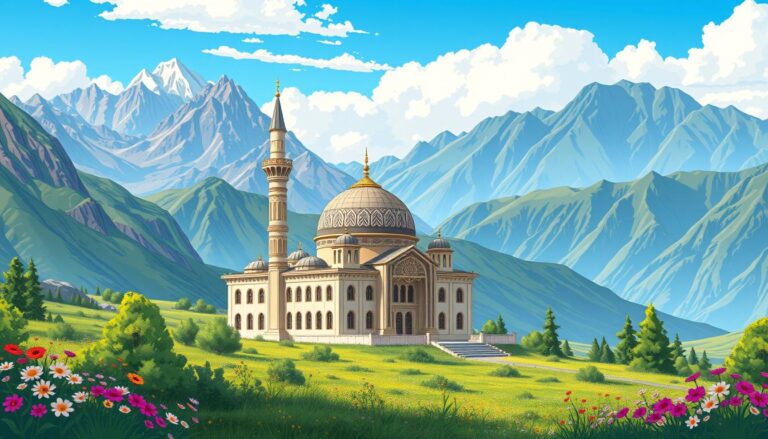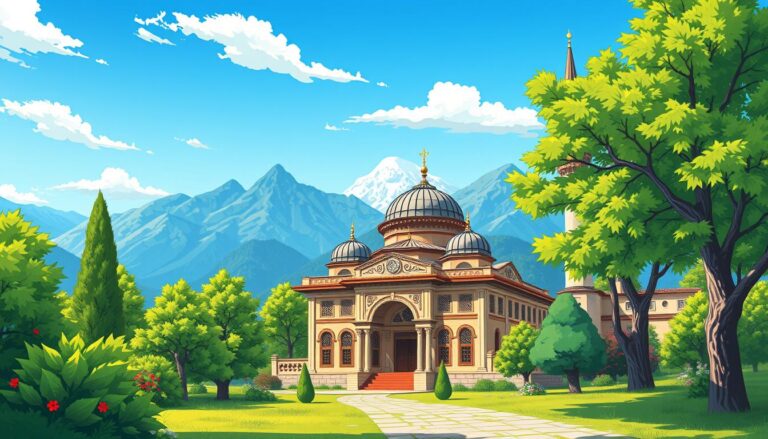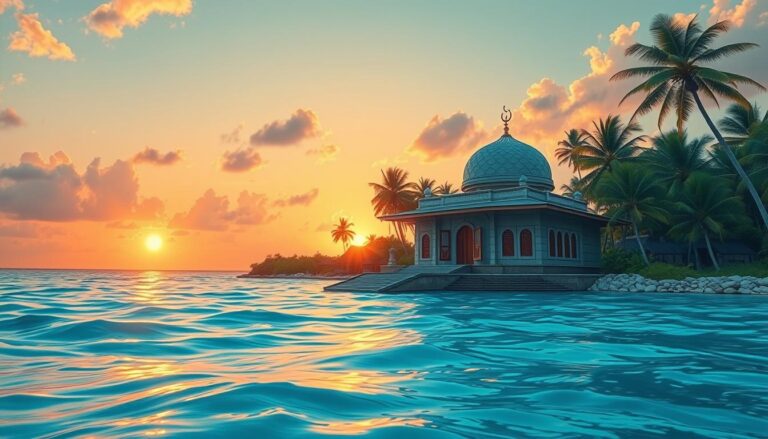Islam in Sierra Leone
Sierra Leone is a West African nation where Islam is a major force. The religion is the largest and majority faith in the country. A 2015 Pew Research Center study found that 78% of Sierra Leone’s people are Muslims, mostly Sunni Islam followers.
This big Islamic presence has greatly influenced Sierra Leone’s culture, society, and history. It makes the country a great example to study the role of Islam in Sierra Leone, the Muslims in Sierra Leone, and the Islamic influence in Sierra Leone.
Sierra Leone is known for being very religiously tolerant. Muslim communities in Sierra Leone and Christian communities live together in peace and work together on many projects. This harmony shows the country’s rich Islamic culture in Sierra Leone and its long history of Qur’anic education in Sierra Leone.
The Prevalence of Islam in Sierra Leone
Sierra Leone, a small West African nation, is known for its rich religious diversity. Yet, Islam stands out as the most popular faith. A stunning 77% of Sierra Leone’s people call themselves Muslim, making Islam the majority religion.
Islam as the Majority Religion
The high number of Muslims in Sierra Leone comes from its diverse ethnic groups. Ten of the country’s sixteen ethnic groups are mostly Sunni Muslim. The Temne and Mende, the two biggest groups, are almost entirely Sunni Muslim.
The northern ethnic groups, like the Fulas, Limbas, Lokos, Mandinkas, Susus, and Korankos, also lean heavily towards Sunni Islam.
Ethnic Groups and Religious Affiliations
- The Temne and Mende ethnic groups, making up around 30% each of Sierra Leone’s population, are predominantly Sunni Muslim.
- The northern ethnic groups, such as the Fulas, Limbas, Lokos, Mandinkas, Susus, and Korankos, are also largely Sunni Muslim.
- The Krio ethnic group, descendants of freed slaves, make up approximately 10% of the population and practice a mix of Christianity and indigenous religions.
- Around 30% of Sierra Leone’s population practices Christianity, while indigenous religions are followed by about 10% of the people.
The strong presence of Islam in Sierra Leone shows the country’s rich cultural heritage. It also highlights the lasting impact of Islam on its diverse ethnic groups.
Sunni Islam: The Predominant Tradition
In Sierra Leone, Sunni Islam is the main religion, with most Muslims following it. The Maliki school of jurisprudence is the top Islamic school in the country.
About 77% of Sierra Leone’s 8.7 million people are Sunni Muslims. The Mende and Temne ethnic groups, making up 32% and 31% of the population, are mostly Sunni. Other groups like the Fula, Loko, Mandinka, Susu, Kono, Kissi, and Sherbro also have many Sunni Muslims.
The Ahmadiyya Muslim community has around 560,000 members, which is 8% of the population. They also follow the Maliki school, showing Sunni Islam’s strong presence. The Rastafarian community, however, is much smaller, with about 25,000 members.
Sunni Islam’s deep roots in Sierra Leone come from its long history and the Maliki school’s influence. This has shaped the country’s religious scene for centuries.
The Historical Roots of Islam in Sierra Leone
The history of Islam in Sierra Leone starts with Muslim merchants from the Mali Empire. They arrived in the northern parts of the country. These merchants connected with local groups like the Temne and built mosques to practice their faith.
This early presence of Islam helped it grow. More people began to convert, making Islam a big part of the culture.
Tracing the Arrival and Spread of Islam
Many things helped Islam spread in Sierra Leone. Trade, missionary work, and the need for safety from war were key. Mande migrants brought goods, military skills, and knowledge of Arabic and Islam.
They used these to make a mark in Sierra Leone. Islamic practices like praying on Fridays and fasting during Ramadan were common. Giving to charity and going on pilgrimage to Mecca were also important.
The blending of local traditions with Islam led to different ways of practicing the faith. This made it hard to define who was truly Muslim. But, groups like the Mandinka, Susu, and Sarakuli were key in building Islamic institutions and spreading the faith.
“The history of Islam in West Africa can be categorized into three stages: containment, mixing, and reform, highlighting the gradual integration and influence of Islam in the region.”
Islamic Practices and Observances
In Sierra Leone, about 77% of people follow Sunni Islam. The Maliki school of jurisprudence guides the Muslim community. Important Islamic holidays like Eid al-Fitr and Eid al-Adha are national holidays.
The Krio people in western Freetown mostly follow Christianity. But in the Northern Province, tribes like the Fula and Mandinka are mostly Muslim. Many people in Sierra Leone marry across religious lines, showing the country’s diverse faiths.
Maliki School of Jurisprudence
The Maliki school is key in Sierra Leone’s Sunni Islam. It focuses on the Quran and the Prophet Muhammad’s teachings. It aims to apply Islamic principles in everyday life.
In Sierra Leone, many blend Christian, Islamic, and animistic beliefs. This mix shows the country’s rich religious culture. Despite differences, people generally live in peace, with the government supporting religious schools.
Prominent Islamic Organizations and Leaders
Sierra Leone has a lively Islamic community. It has many important organizations and leaders. The Sierra Leone Islamic Supreme Council is the top Islamic body. It includes the nation’s respected Imams, scholars, and clerics.
The United Council of Imams is another key group. It gathers all the Imams from mosques across Sierra Leone. These leaders guide Muslims and spread Islam’s teachings.
Some of the most known Sierra Leonean Muslim scholars and preachers are:
- Sheikh Abu Bakarr Cotco Kamara
- Sheikh Muhammad Taha Jalloh
- Sheikh Umarr S. Kanu
- Sheikh Ahmad Tejan Sillah
- Sheikh Saeedu Rahman
- Sheikh Muhammad Habib Sheriff
Sheikh Ahmad Tejan Sillah is a big name. He’s been the Chief Imam of the Freetown Central Mosque since 1985. He’s also been the United Nations Goodwill Ambassador since 2000. He has a master’s in Islamic studies from Qum, Iran, and worked as an Islamist cultural advisor at the Iran embassy in Sierra Leone.
These Islamic organizations in Sierra Leone and their Muslim leaders are crucial. They help shape the country’s religious and cultural scene. They promote peace between faiths and strengthen Islamic identity among Sierra Leoneans.
Islam in Sierra Leone: The Modern Era
In the modern era, Islam has grown significantly in Sierra Leone. The Muslim population has increased from 35% in 1960 to 71% by 2008. This shows Islam’s strong influence in the country. However, the civil war has had a big impact on the Islamic community.
Impact of the Civil War
The Sierra Leone Civil War lasted from 1991 to 2002. It was a secular conflict, with people from different faiths fighting. The war made it hard for Muslims to fulfill the Hajj, a key Islamic pilgrimage.
The distance to Mecca and the cost made it tough for many to go. The 2014-2016 Ebola crisis made things even harder. The civil war and Ebola have greatly affected Muslims’ ability to go on the Hajj.
“The civil war and the Ebola crisis have made it increasingly challenging for Sierra Leonean Muslims to fulfill the Hajj, a fundamental tenet of their faith.”
Despite these challenges, Sierra Leonean Muslims have shown great resilience. They have found ways to keep their faith alive, even with the country’s difficult history.
Christianity and Other Faiths in Sierra Leone
In Sierra Leone, Islam is the main religion, with 77% of people identifying as Muslim. Christianity is the second-largest faith, with 22% of the population. Most Christians in Sierra Leone are Protestants, showing the country’s ties to European missionaries.
Sierra Leone also has a variety of other faiths. These include traditional African religions, Baha’is, Buddhists, Hindus, Jews, atheists, and followers of voodoo and sorcery. These groups make up less than 5% of the population. This diversity shows the country’s rich culture and tolerance.
Interestingly, many people in Sierra Leone see Christianity and Islam as different ways to worship the same God. This mix of religious traditions is seen in the common practice of polygamy among Christian men. It’s also seen in the widespread membership in secret societies with occult rituals, across all religious groups.
The pagan religion, or “Ancestral Practice,” is a big part of Sierra Leonean culture. Its followers seek power and guidance from “devils” through sorcerers and shamans. They believe in communicating with “scary spirits,” seen as dangerous and powerful by many.
Despite the variety of religious beliefs, Sierra Leone has low rates of religious discrimination. Only 6% of cases are reported, compared to higher rates in some neighboring countries. This shows the country’s spirit of interfaith harmony and tolerance, reflecting its rich cultural heritage and the resilience of its people.
Interfaith Harmony and Religious Tolerance
Sierra Leone is known for its religious tolerance. The interfaith harmony and religious tolerance in this West African nation are truly remarkable. At the heart of this peace is the Inter-Religious Council of Sierra Leone. It’s made up of Christian and Muslim leaders.
The council is key in promoting peace and unity in Sierra Leone. During the 2022 anti-government protests, it condemned the violence. It urged religious leaders to spread messages of peace, reconciliation, and national unity.
Sierra Leone’s population shows its religious diversity. About 60% of the people are Muslim, mostly Sunni. And around 30% are Christian. Despite these differences, the people live in harmony.
Many families in Sierra Leone have members from both faiths. They live together, blending their spiritual traditions. This shows the country’s strong social fabric and its people’s commitment to unity.
Islam in Sierra Leone
Islam has a big impact in Sierra Leone, with 78.5% of people following it as of 2020. Its history in the country goes back centuries, starting with Muslim merchants from the Mali Empire. Over time, Islam has grown, shaping the culture and faith of Sierra Leone.
Most Muslims in Sierra Leone follow the Sunni tradition, with the Maliki school of jurisprudence. Important Islamic groups and leaders help guide the faithful and foster unity. Even during the civil war, Islam helped keep people together, with Muslims, Christians, and traditional African religion followers living in peace.
Sierra Leone’s ethnic diversity shows in its religious makeup. The Mende and Temne, the biggest groups, are mostly Sunni Muslim. Other groups, like the Kissi, Kono, and Sherbro, have many Muslims, but more Christians. The Krios are mostly Christian, and the Oku are mostly Muslim.
Islam’s influence goes beyond religion in Sierra Leone. It shapes the culture, architecture, and social norms. Mosques, Islamic holidays, and traditions show Islam’s deep role in Sierra Leonean society.
“Islam has played a pivotal role in the social and cultural development of Sierra Leone, fostering a unique blend of religious, ethnic, and national identity.”
As Sierra Leone grows, Islam’s role stays important. It encourages unity, cultural exchange, and a sense of community among its diverse people.
Conclusion
In conclusion, Islam is a major part of Sierra Leone’s religious scene, with 77% of the population being Muslim. The Islamic history in Sierra Leone started with Muslim merchants from the Mali Empire. Since then, Islam has grown in influence and cultural significance.
Sierra Leone has a lively Muslim community. This community is filled with Islamic organizations, leaders, and practices. These elements help shape the nation’s religious identity.
The Islamic influence is clear in Sierra Leone. Sunni Islam is common among the ethnic tribes in the North. There’s also a big Muslim minority in the South and East, where most people are Christian-affiliated.
The country’s religious tolerance is key. It helps Muslims and Christians live together peacefully. This makes Sierra Leone a harmonious and inclusive place.
Even with challenges like COVID-19 restrictions, the Muslim community in Sierra Leone is doing well. The cultural identity of Muslims is strong.
The government supports interfaith understanding by teaching Christianity, Islam, and other faiths in schools. This shows the government’s effort to keep the country’s religious diversity alive.
Source Links
- Islam in Sierra Leone
- Religion in Sierra Leone
- "we’ll kill you if you cry"
- No title found
- Sierra Leone – United States Department of State
- Sierra Leone – United States Department of State
- Mande Settlement and the Development of Islamic… | Folkstreams
- ISLAM IN A MUSLIM MAJORITY SIERRA LEONE & THE SILENCE OF THE MUSLIMS
- The Spread of Islam in West Africa: Containment, Mixing, and Reform from
- Sierra Leone – United States Department of State
- Sierra Leone – Freedom of Thought Report
- Ahmad Tejan Sillah
- Alusine Jalloh. Muslim Fula Business Elites and Politics in Sierra Leone.
- Muslim Fula Business Elites and Politics in Sierra Leone – Boydell and Brewer
- An Exploration of Traditional African Religions and the Spread of Islam – LEK U CULTURE ASSOCIATION
- Religion in Africa: High tolerance for other faiths
- Traditional African Religion — First Things Foundation
- 2016 Report on International Religious Freedom – Sierra Leone | Refworld
- 2014 Report on International Religious Freedom – Sierra Leone | Refworld
- Sierra Leone – United States Department of State
- Sierra Leone – United States Department of State
